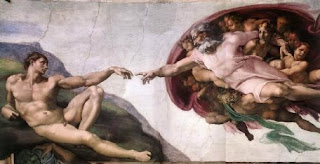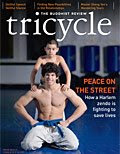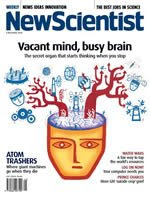
[This is what my talk would be, if the Union Gospel Mission would allow, me, an unordained Buddhist, to give a sermon there. But, ahh, it's, um, not likely that I'll be allowed ... I would guess.]
I want to talk tonight about the fictional children’s story set in the Garden of Eden found in Genesis
1,
2 &
3. It’s a wonderful tale, even better than "Goldilocks and the Three Bears," but like "Goldilocks...," it never truly happened.
It’s an especially swell tale, that Eden thing, though. It’s the OBVIOUS story that a tremendously-insightful ancient person would invent to explain the beginnings of human life.
Think about it: God is Perfect, All-Knowing; Has nothing; Needs nothing. Then, just for kicks, he divides the universe in half.
Before the first day, he creates time, separating it from stillness.
On the first day, he separates darkness and light.
On the second day, he separates heaven and earth. … and so on.
God, ONE UNIFIED PERFECTION, WHICH IS CONTENT FREE, is dividing, like a growing human cell, dividing and multiplying and, in a process of evolution, coming to life. For, what else can he do? Perfection has no counterpart. So, he creates a counterpart by cutting Himself in half an endless number of times.
In the Garden of Eden, which is the opposite of the chaos of the life on earth that God created in the first seven days, He divides Himself from Himself, creating a companion, his image, Adam. And later, to give a companion to Adam – so that Adam can be that much more like God – cuts a piece out of the first man, giving him a woman.
And then, rather slyly, He creates that which is forbidden, separating it from that which is fully available:
The Tree of the Knowledge of Good & Evil and
The Tree of Immortality are forbidden, separate from all of the other vegetation which Adam and Eve may eat. [So now, it seems, that Adam and Eve are made less like God, to whom nothing is forbidden.]
Now, it’s a curious thing. Adam and Eve only know about the The Tree of the Knowledge of Good & Evil, and not about the The Tree of Immortality. [I’ll get back to that later.]
Because it is human nature – or, truly, the nature of all life – to be especially, keenly interested in whatever is forbidden, Adam and Eve end up eating the Fruit of the Tree of Knowledge of Good and Evil, just as God had wanted them to. For now, they are even that much more like God. They are exploring; going beyond themselves, exercising their free will. [For how else, other than by thinking about what you're not supposed to do, can anyone exercise free will?]
God, now, kicks Adam and Eve out of Eden – making them, then, EVEN MORE like God. Remember, God had kicked himself out of “Perfect Oneness which is Content Free.” Now, God is kicking Adam and Eve out of the BORING AS HELL Garden of Eden, where you are not confronted by challenges.
Now, Adam and Eve have left their so-called idyllic spot. Just like us, Adam and Eve have been left to fend for themselves on the dangerous – and sometimes cold and wet – pathways of earth.
Now, we are told, God installs the cherubim and a flaming sword at the gate of Eden to keep Adam and Eve out, lest they eat of the Tree of Immortality. [BTW, be aware that this information seems to tell us that Adam and Eve were never immortal up to this point.]
The cherubim and the flaming sword. What do they represent? Cherubim is plural for cherub. So, here another duality. What are the TWO cherubs? [A cherub is defined as “Usually represented as a pudgy, blond haired child that has wings sprouting from his/her back.”] So, what do the TWO cherubs represent?
- - - -
Let us pause here for a moment.
The story, I hope you all are coming to understand, IS METAPHORIC!!! It is not to be taken as a concrete happening, as conservative, painfully-literalist Christians are inclined to take things.
Why MUST there be a fictional story in the Bible? [A book already full of parables (i.e. fictional stories), I might add.] Because it is only through metaphor that psychological issues can be addressed. Religion is about spiritual matters, not dead rocks. There are some things we cannot tell each other about: specifically, those experiences that happen within the lonely space of our minds. We cannot comprehensively communicate our suffering and gladness. Language is a blunt, crude, wholly-inadequate instrument. Thus, until [referencing
1 Corinthians 13] we meet face to face, and see through the glass clearly] we need metaphor.
- - - -
Now, what do the two cherubs with the flaming sword represent?
Fear and desire.Fear and desire are the two things that bar us from the Tree of Immortality. Fear and desire are the two prime things in human nature that make us unlike God. If we can overcome our fear (primarily of death, but of other things, too) and desire (for the fun, alluring and diverting things to be found on earth), then we would easily pass through the gate and return to Eden.
How do I know that the cherubs represent fear and desire? Because it is the message of overcoming for enlightenment, which is the twin of being born again. But also because that superior religion, Buddhism, TELLS US SO! [See “
Mysticism and beyond: Buddhist phenomenology, part II”]
Buddhism, too, has its famous gate. It’s called the “
gateless gate,” since, in reality, there is nothing barring one from passing through it, EXCEPT those ephemeral twins, FEAR and DESIRE. In the Buddhism theme, one of the guards has his mouth open and the other his mouth closed. But it truth there is nothing to stop you from entering the gate. Indeed, the whole point of your life is for you to pass through the gateless gate.
Many Buddhists, famously, sit in meditation. What does meditation accomplish? It stills the mind. What is the benefit of stilling the mind? It is a return to The One, to the Timeless Now, before God subdivided himself into all things on heaven and earth.
- - - -
Now, remember, in the Garden of Eden story, God has gone from THE ONE to THE MANY. At first God was ONE, then he became THE MANY. The Roman philosopher Plotinus tells us that our life has this path:
Flee the Many, find the One; having found the One, embrace the Many as the One. This path, too, is the ground of The Perennial Philosophy. [You can read some about Plotinus relating to Homeless World Sacramento in a prior post to this blog: "
Phobos and Thanatos"]
- - - -
So, here we are. You and me and Adam and Eve and everybody, possibly including the squirrel in the tree. We are outside of Eden, fending for ourselves in a dangerous world where there is strife, suffering and incredible injustice. Of course, we imagine a perfect world – a land of bliss. It must be somewhere. Metaphorically, it involves a return to Eden – a return to THE ONE.
- - - -
Now, about those trees. INSIDE the Garden of Eden, Adam and Eve were forbidden the fruit of ONE tree, the Tree of the Knowledge of Good and Evil. OUTSIDE the Garden of Eden, there are TWO forbidden trees, the Tree of the Knowledge of Good and Evil AND the Tree of Immortality. Don’t you see!? THE TWO TREES, inside the Garden, ARE ONE AND THE SAME TREE!!! [Inside Eden, before God divided Himself, the trees are one. Outside Eden, in our world of duality, the single tree is seen as two.]
The Garden of Eden tale is telling us that THE WAY BACK INTO THE GARDEN IS THE SAME WAY OUT. But first you must overcome fear and desire. And then, you may eat, again, of the fruit of the tree! MORE knowledge is the return to THE ONE. MORE knowledge is the route to immortality. And what is this knowledge? It is the knowledge of Good and Evil. And what comprises
knowledge of Good and Evil? Wisdom and Compassion. [BTW: It is NOT that wisdom and compassion ARE good and evil; they are THE KNOWLEDGE of Good and Evil.] Once you fully have wisdom and compassion, wisdom & compassion become ONE thing [the TWO become One]: Agape – unalloyed, unconditional, unbounded love.
Once you are ONE, again [like Adam briefly was], YOU WILL KNOW GOD [and knowing God is, of course, the
knowledge of good and evil] and once you know God, you will love everyone unconditionally, as he does, thus EMBRACING THE MANY AS THE ONE. And THAT is the whole point of your life, dear friends [I think]. The Buddha said at enlightenment, "I am one with all things."
- - - -
So, the Garden represents Heaven. But when you embrace the many, you leave heaven and return to the earth with all its messiness. The Kingdom of Heaven, you see, is here. The Kingdom of Heaven is within. The Kingdom is on earth as it is in heaven. Hallowed be thy name.
Here is something I believe, that I've posted before -- though my believing it or not doesn't make any difference. What I believe is that consciousness is all One Thing and that we are all in the Game of Life, a "cosmic game of checkers," together. Here, then, a snippet from a Ken Wilber interview known as "
A Ticket to Athens" which explains things:
Spirit is not good versus evil, or pleasure versus pain, or light versus dark, or life versus death, or whole versus part, or holistic versus analytic. Spirit is the great Player that gives rise to all those opposites equally -- “I the Lord make the Light to fall on the good and the bad alike; I the Lord do all these things” -- and the mystics the world over agree. Spirit is not the good half of the opposites, but the ground of all the opposites, and our “salvation,” as it were, is not to find the good half of the dualism but to find the Source of both halves of the dualism, for that is what we are in truth. We are both sides in the great Game of Life, because we -- you and I, in the deepest recesses of our very Self -- have created both of these opposites in order to have a grand game of cosmic checkers.
- - -
Note: This post is an embellishment of some of Joseph Campbell's ideas in his book "Thou Art That." To Joe: A tip of the hat. My source material is found on ~pg 49-52 which can be seen via Google Books.
 These descriptions of (1) Skeptics and (2) True Believers in Chet Raymo's book "Skeptics and True Believers: The Exhilarating Connection between Science and Religion" sound good to me, but it should be noted that Raymo is, himself, a skeptic -- as am I.
These descriptions of (1) Skeptics and (2) True Believers in Chet Raymo's book "Skeptics and True Believers: The Exhilarating Connection between Science and Religion" sound good to me, but it should be noted that Raymo is, himself, a skeptic -- as am I.


















